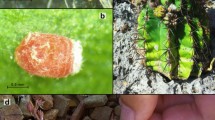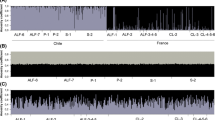Abstract
Introduced organisms experience founder effects including genetic bottlenecks that result in significant reductions in genetic variation. Genetic bottlenecks may constrain the evolution of phenotypic traits that facilitate success in novel habitats. We examined the effect of introduction into novel environments on genetic diversity of an insect pest, Adelges cooleyi, which was introduced into the eastern United States during the mid nineteenth century. We compared variation in mitochondrial and nuclear genomes in native and introduced samples to determine the effect of introduction on genetic variation experienced by this insect. We also measured an ecologically important phenotype, variation in host preference, in both native and introduced samples to compare variation in that trait with molecular genetic variation. To further investigate the relationship between genetic and phenotypic variation, we examined the degree to which mtDNA haplotypes provide information about host preference. Adelges cooleyi in eastern North America has significantly reduced genetic and phenotypic variation, but this low variation does not appear to have prevented persistence in a novel environment. Introduced insects appear to have retained host preference phenotypes similar to those of insects found where introductions likely originated.



Similar content being viewed by others
References
Agrawal AA (2001) Phenotypic plasticity in the interactions and evolution of species. Science 294:321–326. doi:10.1126/science.1060701
Ahern RG, Hawthorne DJ, Raupp MJ (2008) Phylogeography of a specialist insect, Adelges cooleyi: historical and contemporary processes shape the distribution of population genetic variation. Mol Ecol (submitted)
Annand PN (1928) A contribution toward a monograph of the Adelginae (Phylloxeridae) of North America. Biol Sci 6:2–146
Apple ME, Olszyk DM, Ormrod DP et al (2000) Morphology and stomatal function of Douglas fir needles exposed to climate change: elevated CO2 and temperature. Int J Plant Sci 161:127–132. doi:10.1086/314237
Avise JC (2000) Phylogeography: the history and formation of species. Harvard University Press, Cambridge
Baker HG (1965) Characteristics and modes of origin of weeds. In: Baker HG, Drake JA (eds) The genetics of colonizing species. Academic Press, New York, pp 147–172
Brennan EB, Weinbaum SA (2001) Effect of epicuticular wax on adhesion of psyllids to glaucous juvenile and glossy adult leaves of Eucalyptus globulus Labillardiere. Aust J Entomol 40:270–277. doi:10.1046/j.1440-6055.2001.00229.x
Burdon JJ, Thrall PH (2004) Genetic structure of natural plant and pathogen populations. In: Ehler LE, Sforza R, Mateille T (eds) Genetics, evolution and biological control. CABI Publishing, Cambridge, pp 1–15
Cock MJW (1978) The assessment of preference. J Anim Ecol 47:805–816. doi:10.2307/3672
Cox GW (2004) Alien species and evolution: the evolutionary ecology of exotic plants, animals, microbes and interacting native species. Island Press, Washington
Cranshaw WS (1989) Patterns of gall formation by the Cooley spruce gall adelgid on Colorado blue spruce. J Arboric 15:277–288
Dlugosch KM, Parker IM (2007) Founding events in species invasions: genetic variation, adaptive evolution, and the role of multiple introductions. Mol Ecol 17:431–449
Drake JM (2004) Allee effects and the risk of biological invasion. Risk Anal 24:795–802. doi:10.1111/j.0272-4332.2004.00479.x
Drake JM, Lodge DM (2006) Allee effects, propagule pressue and the probability of establishment: risk analysis for biological invasions. Biol Invasions 8:365–375. doi:10.1007/s10530-004-8122-6
Eigenbrode SD (1995) Effects of plant epicuticular lipids on insect herbivores. Annu Rev Entomol 40:171–194. doi:10.1146/annurev.en.40.010195.001131
Elderkin CL, Perkins EJ, Leberg PL, Klerks PL, Lance RF (2004) Amplified fragment length polymorphism (AFLP) analysis of the genetic structure of the zebra mussel, Dreissena polymorpha, in the Mississippi River. Freshw Biol 49:1487–1494. doi:10.1111/j.1365-2427.2004.01285.x
Ellstrand NC, Schierenbeck KA (2000) Hybridization as a stimulus for the evolution of invasiveness in plants? Proc Natl Acad Sci USA 97:7043–7050. doi:10.1073/pnas.97.13.7043
Excoffier L, Smouse PE, Quattro JM (1992) Analysis of molecular variance inferred from metric distances among DNA haplotypes: application to human mitochondrial DNA restriction data. Genetics 131:479–491
Excoffier L, Laval G, Schneider S (2005) Arlequin ver. 3.0: an integrated software package for population genetics data analysis. Evol Bioinform Online 1:47–50
Feder JL, Chilcote CA, Bush GL (1990) The geographic patterns of genetic differentiation between host associated populations of Rhagoletis pomonella (Diptera: Tephritidae) in the eastern United States and Canada. Evol Int J Org Evol 44:570–594. doi:10.2307/2409436
Futuyma DJ, McCafferty (1990) Phylogeny and the evolution of host plant associations in the leaf beetle Ophraella (Coleopter, Chrysomelidae). Evol Int J Org Evol 44:1885–1913. doi:10.2307/2409602
Futuyma DJ, Peterson SC (1985) Genetic variation in the use of resources by insects. Annu Rev Entomol 30:217–238. doi:10.1146/annurev.en.30.010185.001245
Gillette CP (1907) Chermes of Colorado conifers. Proc Natl Acad Sci Philadelphia 59:3–22
Grapputo A, Boman S, Lindstrom L, Lyytinen A, Mappes J (2005) The voyage of an invasive species across continents: genetic diversity of North American and European Colorado potato beetle populations. Mol Ecol 14:4207–4219
Hajibabaei M, Janzen DH, Burns JM, Hallwachs W, Hebert PDN (2006) DNA barcodes distinguish species of tropical Lepidoptera. Proc Natl Acad Sci USA 103:968–971. doi:10.1073/pnas.0510466103
Hartl DL, Clark AG (1997) Principles of population genetics, 3rd edn. Sinauer Associates, Inc., Sunderland
Hastings A, Cuddington K, Davies KF et al (2005) The spatial spread of invasions: new developments in theory and evidence. Ecol Lett 1:91–101. doi:10.1111/j.1461-0248.2004.00687.x
Hawthorne DJ (1997) Ecological hostory and evolution in a novel environment: habitat heterogeneity and insect adaptation to a new host plant. Evol Int J Org Evol 51:153–162. doi:10.2307/2410968
Hedrick PW, Ginevan ME, Ewing EP (1976) Genetic polymorphism in heterogeneous environments. Annu Rev Ecol Syst 7:1–32. doi:10.1146/annurev.es.07.110176.000245
Hewitt GM (1996) Some genetic consequences of ice ages, and their role in divergence and speciation. Biol J Linn Soc 58:247–276
Hewitt GM (2001) Speciation, hybrid zones, and phylogeography – or seeing genes in space and time. Mol Ecol 10:537–549. doi:10.1046/j.1365-294x.2001.01202.x
Iline II, Phillips CB (2004) Allozyme markers to help define the South American origins of Microctonus hyperodae (Hymenoptera: Braconidae) established in New Zealand for biological control of Argentine stem weevil. Bull Entomol Res 94:229–234. doi:10.1079/BER2004303
Ivanova NV, de Waard JR, Hebert PDN (2006) An inexpensive, automation-friendly protocol for recovering high-quality DNA. Mol Ecol Notes 6:998–1002. doi:10.1111/j.1471-8286.2006.01428.x
Johnston JA, Donovan LA, Arnold ML (2004) Novel phenotypes among early generation hybrids of two Louisiana iris species: flooding experiments. J Ecol 92:967–976. doi:10.1111/j.1365-2745.2004.00939.x
Kolbe JJ, Glor RE, Schettino LR et al (2004) Genetic variation increases during biological invasion by a Cuban lizard. Nature 431:177–181. doi:10.1038/nature02807
Lee CE (2002) Evolutionary genetics of invasive species. Trends Ecol Evol 17:386–391. doi:10.1016/S0169-5347(02)02554-5
Leung B, Drake JM, Lodge DM (2004) Predicting invasions: propagule pressure and the gravity of allee effect. Ecology 85:1651–1660. doi:10.1890/02-0571
Li P, Adams WT (1989) Range-wide patterns of allozyme variation in Douglas-fir (Pseudotsuga menziesii). Can J For Res 19:149–161. doi:10.1139/x89-022
Lipscomb B (1993) Flora of North America North of Mexico. Oxford Univerity Press, New York and Oxford
Little EL Jr (1971) Atlas of the United States trees, volume 1, conifers and important hardwoods, pp. 9, 200 maps. U.S. Department of Agriculture
Mack RN, Simberloff D, Lonsdale WM et al (2000) Biotic invasions: causes, epidemiology, global consequences, and control. Ecol Appl 10:689–710. doi:10.1890/1051-0761(2000)010[0689:BICEGC]2.0.CO;2
Mackauer M (1976) Genetic problems in the production of biological control agents. Annu Rev Entomol 21:369–385. doi:10.1146/annurev.en.21.010176.002101
Mock KE, Bentz BJ, O’Neill EM et al (2007) Landscape-scale genetic variation in a forest outbreak species, the mountain pine beetle (Dendroctonus ponderosae). Mol Ecol 16:553–568. doi:10.1111/j.1365-294X.2006.03158.x
Mooney HA, Cleland EE (2001) The evolutionary impact of invasive species. Proc Natl Acad Sci USA 98:5446–5451. doi:10.1073/pnas.091093398
Moran NA (1988) The evolution of host-plant alternation in aphids: evidence for specialization as a dead end. Am Nat 132:681–706. doi:10.1086/284882
Muluvi GM, Sprent JI, Soranzo N et al (1999) Amplified fragment length polymorphism (AFLP) analysis of genetic variation in Moringa oleifera Lam. Mol Ecol 8:463–470. doi:10.1046/j.1365-294X.1999.00589.x
Parsons YM, Shaw KL (2001) Species boundaries and genetic diversity among Hawaiian crickets from the genus Laupala identified using amplified fragment length polymorphism. Mol Ecol 10:1765–1772. doi:10.1046/j.1365-294X.2001.01318.x
Price PW (1997) Insect ecology, 3rd edn. John Wiley & Sons, Inc., New York
Rehfeldt GE (1977) Growth and cold hardiness of intervarietal hybrids of Douglas-fir. Theor Appl Genet 50:3–15. doi:10.1007/BF00273790
Rehfeldt GE (1978) The genetic structure of a population of Douglas-fir (Pseudotruga menziesii var. glauca) as reflected by its wind-pollinated progenies. Silvae Genet 27:49–52
Reveal J (1992) Gentle conquest: the botanical discovery of North America with illustrations from the Library of Congress. Starwood Publishing, Washington
Rhymer JM, Simberloff D (1996) Extinction by hybridization and introgression. Annu Rev Ecol Syst 27:83–109. doi:10.1146/annurev.ecolsys.27.1.83
Scheffer SJ, Grissell EE (2003) Tracing the geographical origin of Megastigmus transvaalensis (Hymenoptera: Torymidae): an African wasp feeding on a South American plant in North America. Mol Ecol 12:415–421. doi:10.1046/j.1365-294X.2003.01725.x
Stadler T, Frye M, Neiman M, Lively CM (2005) Mitochondrial haplotypes and the New Zealand origin of clonal European Potamopyrgus, an invasive aquatic snail. Mol Ecol 14:2465–2473. doi:10.1111/j.1365-294X.2005.02603.x
Stephan BR (1987) Differences in the resistance if Douglas fir provenances to the woolly aphid Gilletteella cooleyi. Silvae Genet 36:76–79
Suarez AV, Tsutsui ND, Holway DA, Case TJ (2004) Behavioral and genetic differentiation between native and introduced population of the Argentine ant. Biol Invasions 1:43–53. doi:10.1023/A:1010038413690
Sullivan JH, Teramura AH (1988) Effects of ultra-violet-B irradiation on seed growth in the Pinaceae. Am J Bot 75:225–230. doi:10.2307/2443888
Taylor AC, Cowan PE, Fricke BL et al (2004) High microsatellite diversity and differential structuring among populations of the introduced common brushtail possum, Trichosurus vulpecula, in New Zealand. Genet Res 83:101–111. doi:10.1017/S001667230400672X
Tsutsui ND, Suarez AV, Holway DA, Case TJ (2000) Reduced genetic variation and the success of an invasive species. Proc Natl Acad Sci USA 97:5948–5953. doi:10.1073/pnas.100110397
Tsutsui ND, Suarez AV, Holway DA, Case TJ (2001) Relationships among native and introduced populations of the Argentine ant (Linepithema humile) and the source of introduced populations. Mol Ecol 10:2151–2161. doi:10.1046/j.0962-1083.2001.01363.x
Via S (1991) The genetic structure of host plant adaptation in a spatial patchwork: demographic variability among reciprocally transplanted pea aphid clones. Evol Int J Org Evol 45:827–852. doi:10.2307/2409692
Vos P, Hogers R, Bleeker M et al (1995) AFLP: a new technique for DNA fingerprinting. Nucleic Acids Res 23:4407–4414. doi:10.1093/nar/23.21.4407
Zar JH (1998) Biostatistical analysis, 4th edn. Prentice Hall, Upper Sadle River
Acknowledgements
The authors would like to thank Galen Dively, Matthew Hare, Sonja Scheffer, Kerry Shaw, and four anonymous reviewers for valuable comments that improved an earlier version of this manuscript. Bob Foottit and Nathan Havill provided expertise and primers, respectively. Joan West provided technical assistance, and Whitney Cranshaw, Ruth Hufbauer, Carol von Dohlen, and Jill O’Donnell assisted with collection and collection trips. We would also like to thank Susan Newhart, Larry May, Don and Joan Hilliker; David Walker; Tom Brobson and David Brady for graciously allowing and facilitating collection efforts on their personal property. Sequencing was supported by funding to the Canadian Barcode of Life Network from Genome Canada (through the Ontario Genomics Institute), NSERC and other sponsors listed at www.BOLNET.ca.
Author information
Authors and Affiliations
Corresponding author
Rights and permissions
About this article
Cite this article
Ahern, R.G., Hawthorne, D.J. & Raupp, M.J. Founder effects and phenotypic variation in Adelges cooleyi, an insect pest introduced to the eastern United States. Biol Invasions 11, 959–971 (2009). https://doi.org/10.1007/s10530-008-9308-0
Received:
Accepted:
Published:
Issue Date:
DOI: https://doi.org/10.1007/s10530-008-9308-0




